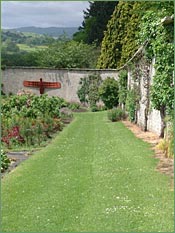|
|
 |
The four and a half acres of gardens are a Pandora's
box of surprises, winding paths, borders, a stream, organic vegetables,
walls, fell views. It is without doubt a magical place, dearly loved
by custodians and customers alike. Perhaps the Jewel in the crown
of this secret garden is the tranquillity and serenity of the 16th
century churchyard, an incredible place of peace and quiet where one
can sit and simply be with ones thoughts.
To enhance your visit or just to give children something to do, a series of numbered stones can be followed around the gardens, remembering of course that what you see will be dependent on the time of year
 On
passing Stone 1 to your left are
the Amelanchiers whose fiery red foliage illuminates the autumn garden.
With spring blossom in abundance and edible fruit it's a real three-season
tree. Beneath these, in season you'll find Ranunculus aconitiflium
fl-pl, variegated blackberry and Gordon's very own Geranium with irridescent
blue flowers. On
passing Stone 1 to your left are
the Amelanchiers whose fiery red foliage illuminates the autumn garden.
With spring blossom in abundance and edible fruit it's a real three-season
tree. Beneath these, in season you'll find Ranunculus aconitiflium
fl-pl, variegated blackberry and Gordon's very own Geranium with irridescent
blue flowers.
Stone 2 follows along the herbaceous
border, notables are Abutilon, Gillenia trifoliata, Cirsium rivularis
atropurpureum.
Stone 3 turns you left along another
border, look out for the different Sambucus forms.
Stone 4 follows the gravel path along the Beech hedge to
Stone 5 which cuts through the mixed shrubbery where Epimediums,
Stephanandra, Angelica, Aucuba and Acers reside alongside the late
summer flowering giants Campanula lactiflora. You then enter into
the lower borders by the smoke bush Cotinus coggygria, take time here
to enjoy the Column-Yews, the enormous Garrya eliptica, and the ancient
Contorted Hazel.
 Stone
6 will take you from the lower lawn, under the Beech arch to
Stone 7 and along the middle path
with many more noteworthy plants like Viburnum tomentosum and Liriodendron
or 'Tulip tree', under which at Stone
6 will take you from the lower lawn, under the Beech arch to
Stone 7 and along the middle path
with many more noteworthy plants like Viburnum tomentosum and Liriodendron
or 'Tulip tree', under which at
Stone 8 you will find Snowdrops, Alliums,
Fritillaries and the wonderful Dog's Tooth Violet according to the
month. Notice also the attractive 'Paper bark Maple' Acer griseum
on the way to
Stone 9 which interestingly loops you round by the dogs graves,
where you will find Meconopsis grandis, Primula japonica, and the
mighty Rheum palmatum atropurpureum.
Stone 10 will direct you towards
the old Churchyard by Stone 11,
but notice the lovely variegated lilac 'Syringa emodi' en route, it
is both rare and beautiful. Stone 12
will guide you out onto the path and Stone
13 by the rare Berberis temalica will take you up the potting
shed path. Plants along here include Cimicifuga racemosa atropurpureum,
Jasminium beesiana, Veratrum album and philadelphus coronarius variegatus.
Continue ahead to Stone 14 by Prunus
'kanzan' a real cracker of a tree in spring and autumn.
Stone 15 directs you along the streamside
and the vegetable garden.
Stones 16 and 17 are sited by
steps leading down to old stone troughs over 200 years old and bedded
into the stream. It is here over the centuries that generations of
gardeners have washed the veg. before taking it to the hall kitchens
quite ingenious really! 
Follow Stone 18 along the top wall.
Along here you can look out over our little world here at Eggleston,
but as you reach the seat at Stone 19,
look behind you, that world's a little larger!
Stone 20 will take you through the vegetable
garden, the excess produce can be bought in the shop or potting shed,
depending on what is available in season.
By Stone 21 you will be aware
we grow many spiky silver-leafed plants, they are not European pineapples
as I led a couple of ladies to believe, they are Celmisia spectablilis
'Eggleston silver' possibly one of the most sought after plants. Fully
hardy, beautiful white flowers, and unusual evergreen foliage.
I hope this edited virtual tour was of help! |
| |
|
